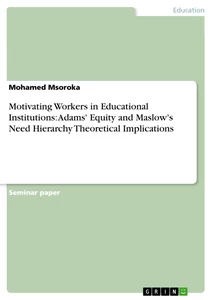

Anything contributed to your work Outputs: Money, benefits, flexibility, autonomy, responsibility, promotions The individual chooses who to compare themselves to Imputs: Experience, effort, a skill, education. The comparison other is not specified by the theory. Three terms are important in this theory: Comparison others: can be a co-worker, yourself in past experiences, or an ideal. This can be illustrated by the following equation: If both employees were perhaps rewarded the same, it would help the workforce realize that the organization is fair, observant, and appreciative. This is in direct contrast with the idea of equity theory, the idea is to have the rewards (outcomes) be directly related with the quality and quantity of the employees contributions (inputs). This dissatisfaction would result in the employee feeling underappreciated and perhaps worthless. Persuade the employee to be dissatisfied. If an employee notices that another person is getting more recognition and rewards for their contributions, even when both have done the same amount and quality of work, it would The way people base their experience with satisfaction for their job is to make comparisons with themselves to people they work with. Thus, all else being equal, it would be acceptable for a more senior colleague to receive higher compensation, since the value of his experience (and input) is higher. Rather, Equity, and the sense of fairness which commonly underpins motivation, is dependent on the comparison a person makes between his or here reward/investment ratio with the ratio enjoyed (or suffered) by others considered to be in a similar situation.ĭefinition of equity An individual will consider that he is treated fairly if he perceives the ratio of his inputs to his outcomes to be equivalent to those around him. Equity, and thereby the motivational situation we might seek to assess using the model, is not dependent on the extent to which a person believes reward exceeds effort, nor even necessarily on the belief that reward exceeds effort at all. The way that people measure this sense of fairness is at the heart of Equity Theory. When people feel fairly or advantageously treated they are more likely to be motivated when they feel unfairly treated they are highly prone to feelings of disaffection and demotivation. The Adams' Equity Theory model therefore extends beyond the individual self, and incorporates influence and comparison of other people's situations - for example colleagues and friends - in forming a comparative view and awareness of Equity, which commonly manifests as a sense of what is fair. However, awareness and cognizance of the wider situation - and crucially comparison - feature more strongly in Equity Theory than in many other earlier motivational models. There are similarities with Charles Handy's extension and interpretation of previous simpler theories of Maslow, Herzberg and other pioneers of workplace psychology, in that the theory acknowledges that subtle and variable factors affect each individual's assessment and perception of their relationship with their work, and thereby their employer.

The Equity Theory – John Stacey Adams John Stacey Adams, a workplace and behavioural psychologist, put forward his Equity Theory on job motivation in 1963.


 0 kommentar(er)
0 kommentar(er)
